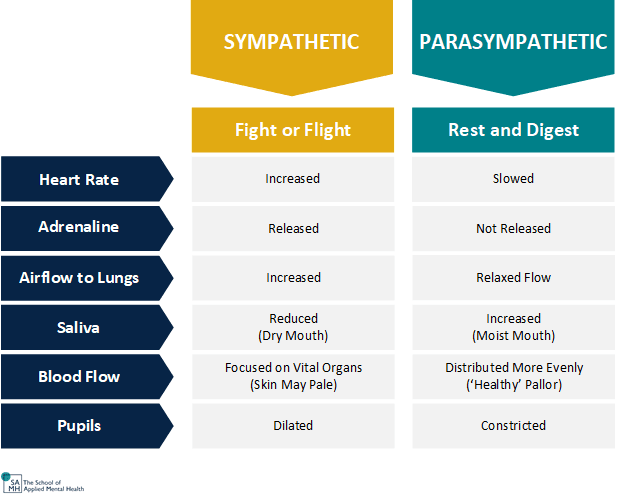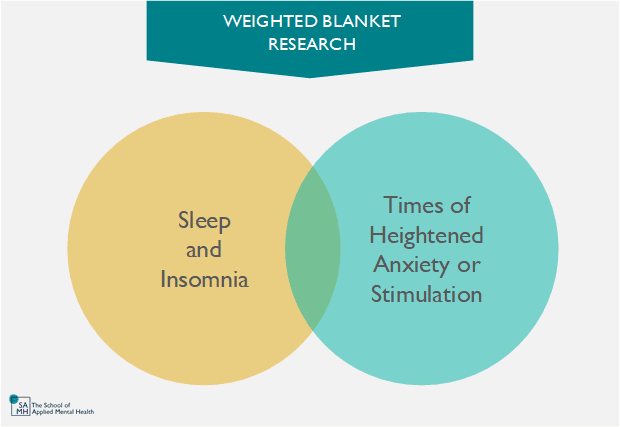Weighted Blankets – The Science of how they work.
Do weighted blankets really work or are they over-rated?
Do weighted blankets work and how do you choose one?
Weighted blankets have hit the mainstream. Everyone from Vogue magazine to Good Housekeeping are reviewing the best weighted blankets to help with anxiety, sleep, stress and a range of other conditions. Even Disney are on the bandwagon with their own range for kids.
Is this a passing trend, or is there real potential to help those who are struggling with their mental health? In this post we dive under the covers (sorry!) and use the latest research to answer these key questions:
– What are weighted blankets?
– How do they work and who do they help?
– how to choose a blanket and whether to recommend them?
This article is designed for mental health professionals as well as anyone wanting to choose the right blanket for themselves or a loved one.
The Basics: What are weighted blankets?
A weighted blanket is a blanket that contains weighted material, designed to exert a comforting physical pressure on the user. They use glass beads, weighted disks or chains, or the inherent weight of woven materials such as wool to provide the desired weight.
As a guide, blankets should be around 10-12% of the user’s own bodyweight for the best outcome (the goldilocks zone of not to heavy and not too light) [1],[2]. Common blanket weights range from 2kg for children up to 11.5kg for larger adults.
Originally marketed as a non-pharmacological intervention (i.e. a drug free therapeutic aid), they are now promoted to a huge range of potential customers. Shops, Instagram Ads and marketing campaigns suggest weighted blankets benefit those with:
- Anxiety
- Insomnia and other sleep disorders
- Stress
- Post-Traumatic Stress Disorder (PTSD)
- Autism Spectrum Disorder (ASD)
- Attention Deficit Hyperactivity Disorder (ADHD)
- Fibromyalgia (linked to anxiety and depression)
- Restless legs
- Recovery after sports & workouts (linked to the autonomic nervous system)
Quite a list isn’t it? So, is this all just hype or does research support their use?
The Science: How do they work and who do they help?
As with any mental health resource, it’s important to understand the science, risks and efficacy before recommending them to others or choosing one for yourself. After all, the companies selling the blankets won’t be the most objective! We have said it before in our courses for mental health professionals but it’s worth repeating… every time you make a recommendation, you are placing your own professional reputation on that product or resource.
Luckily though, we have done the reading for you, so let’s take a look.
Put simply, studies about the blankets are sparse but are usually very encouraging. Most agree that they work through stimulation and sensory experience. Specifically, they provide Deep Pressure Stimulation (DPS).
Deep Pressure Stimulation is the application of firm but gentle pressure to an individual’s body. It is a tactile sensation that helps decrease the ‘fight or flight response (sympathetic nervous system) and increases ‘rest and digest’ response (parasympathetic nervous system).

As a secondary (really practical) factor, blankets also provide a moment of calm and physical relaxation. The blanket requires us to take some time just sat or lying down. This can sometimes be hard to make time without the justification of the blanket.
But what does this mean in practice? What do weighted blankets feel like?
Users have reported feeling ‘cocooned’, ‘hugged’ and ‘comforted’ by the blankets (sounds nice doesn’t it). This is likely to be a result of consistent pressure stimulation impacting autonomic nervous system. That consistent sensory input (just like a hug or swaddling) reduces physiological arousal. [3][4]
After reviewing a number of studies, it’s clear to us that researchers have focused on two main categories: using weighted blankets for improving sleep or to help with heightened anxiety / over-stimulation.

Weighted blankets for improving sleep and insomnia
Quality sleep is essential for quality of life. You are likely to have experienced moment of poor sleep yourself, or if you are a mental health professional you will have worked with countless individuals who have been affected by poor quality sleep or insomnia. This can either be a factor in, or a symptom of, worsening mental health.
There is a clear link between poor sleep and poor brain functioning. In fact, lack of sleep can cause effects similar to being over the legal alcohol limit.[5] We need sleep not only to feel physically rested but to help us create and recall memories and simply to form words.[6]
Stress, worry, anxiety, depression, bipolar disorder, flashbacks, addiction, ADHD and autism are all linked to symptoms of poor sleep. No wonder researchers want to find anything that might help.
What do the findings tell us?
Results have been really encouraging. Using a sample of adult volunteers with major depressive disorder, bipolar disorder, generalized anxiety disorder (GAD) or ADHD, one trial found:
“weighted blankets resulted in a significantly better sleep-maintenance, a higher daytime activity level and reduced daytime symptoms of fatigue, depression and anxiety”.[7]
Luckily for us, that’s not a one-off result. Other studies support this, finding that sleep increased when using the blankets and activity during the night decreased.[8] These positive results also found no major safety concerns in their use for adults (we will cover this a bit more in a minute).
There is a limit though… There has been a lot of interest in whether weighted blankets can help with sleep problems for children with autism (probably linked to the well-established use of weighted vests as a form of Deep Pressure Therapy).
Looking objectively, there appears to be little to no evidence to show a benefit from using the blankets for sleep in this context.[9] However, parents perceived them to be more effective than they actually were (although some children did not take well to them).[10]
Weighted blankets for heightened anxiety
Do you remember that we said the blankets worked via deep pressure stimulation, calming the nervous system? Well, other forms of deep pressure therapy (such as weighted vests) have already been found to help those with sensory over-responsivity (SOR) and to aid in reducing daytime anxiety.
For those managing anxiety at home, weighted blankets can have a calming effect even when used briefly. 78% of users in one study reported reduced anxiety after 5-minute sessions with the weighted blanket.[11]
Outside of the home and in acute inpatient psychiatric units, those using weighted blankets (as part of a sensory room) experienced significant reductions in distress and clinician rated anxiety. [12] In fact, the blankets were the most popular item in the room.
Even for those without a clinical anxiety diagnosis (or any psychiatric or mental health illness) the effects are just as meaningful. Life events can be extremely difficult at times. Weighted blankets can be a cheap wellbeing self-help during cancer treatment. Chemotherapy patients given weighted blankets on their first or second chemo infusions felt reduced levels of anxiety during one randomised control trial.[13] A similar calming effect has also been found with weighted blankets used at the dentist.[14] These studies offer up real hope that the stresses of hospital procedures could be reduced without medication or side effects and at low cost.
How to choose a weighted blanket?
As we have seen, weighted blankets have the potential to be simple and effective aids for those suffering from a variety of mental health concerns. But with so much choice out there, how do we choose the right blanket?
Safety & Suitability
Are weighted blankets safe? Studies have found that a blanket weight of 13kg is safe and effective for adults who don’t have complicating medical conditions.[15] Naturally though, there are some limits and they aren’t suitable for everyone. Those who are pregnant, under 3 years old or suffering from conditions that may affect breathing or circulation (such as sleep apnoea, asthma or diabetes) should not use them. Clients should seek medical advice if they have any complicating medical conditions before using them.
Clients should also be made aware of the need to choose a blanket that suits their own body weight. This may raise issues for those who have body weight issues/body dysmorphia and may require sensitive discussion or selection/purchase by a parent, caregiver or someone else on their behalf.
Clients who are more sensitive to stimulation may want to consider a lighter blanker or building up to a comfortable weight (noting that most benefit is found around 10-12% of body weight).[16]
If you are looking for a weighted blanket with professional backing, endorsement or certification you are unlikely to find one currently. While there is lots of choice available professional bodies are yet to back any particular brand. This leaves it up to personal choice but it is important to buy from a reputable seller as this will help ensure your countries product safety standards are met.
Cost and Choice
There is a lot of choice out there. How do you choose a blanket for yourself or what should you say when a client asks you ‘what weighted blanket is best’? Where do I start?
Other than the correct weight, it is simply personal preference. There are many different price points available and a no-one should feel pressured into buying a specific brand or high cost item. People may wish to consider if they want one that will be cool or warm, washable, single or double, and or simply one they like the look of (which may help with any hesitance to use it).
If they are ethically minded, there are also sustainable options (which are usually more expensive) including organic cotton and natural materials.
Blankets are available in department stores, supermarkets and online retailers. A quick online search will provide countless options.
Conclusions
Are weighted blankets worth it? Should you use them yourself or recommend them to others?
Yes (probably). They can be low cost, accessible tools for those who are struggling with their mental health and are medication free tools for anxiety and insomnia (perhaps linked to ADHD, depression, fibromyalgia and other conditions). They can be used long term or short term and are widely available to buy. Although there is space for more research, there is little risk in trying them out and many people have reported very real benefits.
Custom CSS Box
Your content goes here. Edit or remove this text inline or in the module Content settings. You can also style every aspect of this content in the module Design settings and even apply custom CSS to this text in the module Advanced settings.
How to Reference this Blog Post
Suggested reference for this post:
School of Applied Mental Health (2020). Do weighted blankets work? Available from: https://www.schoolofappliedmentalhealth.com/weighted-blankets
References
[1] Mullen, B., Champagne, T., Krishnamurty, S., Dickson, D., and Gao, R. X. (2008). Exploring the Safety and Therapeutic Effects of Deep Pressure Stimulation Using a Weighted Blanket. Occupational Therapy in Mental Health, 24(1), pp. 65-89. Available from: https://www.tandfonline.com/doi/abs/10.1300/J004v24n01_05
[2] Ackerley, R., Badre, G., and Olausson, H. (2015). Positive Effects of a Weighted Blanket on Insomnia. Journal of Sleep Medicine and Disorders, 2(3). Available from: https://www.jscimedcentral.com/SleepMedicine/sleepmedicine-2-1022.pdf
[3] Ackerley, R., Badre, G., and Olausson, H. (2015). Positive Effects of a Weighted Blanket on Insomnia. Journal of Sleep Medicine and Disorders, 2(3). Available from: https://www.jscimedcentral.com/SleepMedicine/sleepmedicine-2-1022.pdf
[4] Clapp, A. (2019). Effects of Weighted Blankets on College Students’ Anxiety [online]. Honours Project, Illinois Wesleyan University. Available from: https://core.ac.uk/reader/212842716
[5] Dawson D, Reid K. Fatigue, alcohol and performance impairment. Nature 1997;388(6639):235
[6] Thorley, C. (2013). The Effects of Recent Sleep Duration, Sleep Quality, and Current Sleepiness on Eyewitness Memory. Available from: https://www.onlinelibrary.wiley.com/doi/pdf/10.1002/acp.2938
[7] Ekhom, B., Spulber, S., and Alder, M. (2020). A Randomized Controlled Study of Weighted Chain Blankets for Insomnia in Psychiatric Disorders. Journal of Clinical Sleep Medicine. Available from: https://pubmed.ncbi.nlm.nih.gov/32536366/
[8] Ackerley, R., Badre, G., and Olausson, H. (2015). Positive Effects of a Weighted Blanket on Insomnia. Journal of Sleep Medicine and Disorders, 2(3). Available from: https://www.jscimedcentral.com/SleepMedicine/sleepmedicine-2-1022.pdf
[9] Charleson, J. (2014). Effectiveness of Weighted Blankets as an Intervention for Sleep Problems in Children with Autism [online]. Masters Thesis, University of Canterbury. Available from: https://core.ac.uk/reader/35471351
[10] Charleson, J. (2014). Effectiveness of Weighted Blankets as an Intervention for Sleep Problems in Children with Autism [online]. Masters Thesis, University of Canterbury. Available from: https://core.ac.uk/reader/35471351
[11] Mullen, B., Champagne, T., Krishnamurty, S., Dickson, D., and Gao, R. X. (2008). Exploring the Safety and Therapeutic Effects of Deep Pressure Stimulation Using a Weighted Blanket. Occupational Therapy in Mental Health, 24(1), pp. 65-89. Available from: https://www.tandfonline.com/doi/abs/10.1300/J004v24n01_05
[12] Novak, T., Scanlan, J., McCaul, D., MacDonald, N., and Clarke, T. (2012). Pilot Study of a Sensory Room in an Acute Inpatient Psychiatric Unit. Australas Psychiatry, 20(2), pp. 401-406. Available from: https://pubmed.ncbi.nlm.nih.gov/23014117/
[13] Vinson, J., Powers, J., and Mosesso, K. (2020). Weighted Blankets: Anxiety Reduction in Adult Patients Receiving Chemotherapy. Clinical Journal of Oncology Nursing, 24(4), pp. 360-368. Available from: https://europepmc.org/article/med/32678376
[14] Chen, H-S., Yang, H., Chi, H-J., and Chen, H-M. (2012). Physiological Effects of Deep Touch Pressure on Anxiety Alleviation: The Weighted Blanket Approach. Journal of Medical and Biological Engineering, 33(5), pp. 463-470. Available from: https://autismevriendelijkemondzorg.nl/wp-content/uploads/2015/02/Chen-.pdf
[15] Mullen, B., Champagne, T., Krishnamurty, S., Dickson, D., and Gao, R. X. (2008). Exploring the Safety and Therapeutic Effects of Deep Pressure Stimulation Using a Weighted Blanket. Occupational Therapy in Mental Health, 24(1), pp. 65-89. Available from: https://www.tandfonline.com/doi/abs/10.1300/J004v24n01_05
[16] Ackerley, R., Badre, G., and Olausson, H. (2015). Positive Effects of a Weighted Blanket on Insomnia. Journal of Sleep Medicine and Disorders, 2(3). Available from: https://www.jscimedcentral.com/SleepMedicine/sleepmedicine-2-1022.pdf

